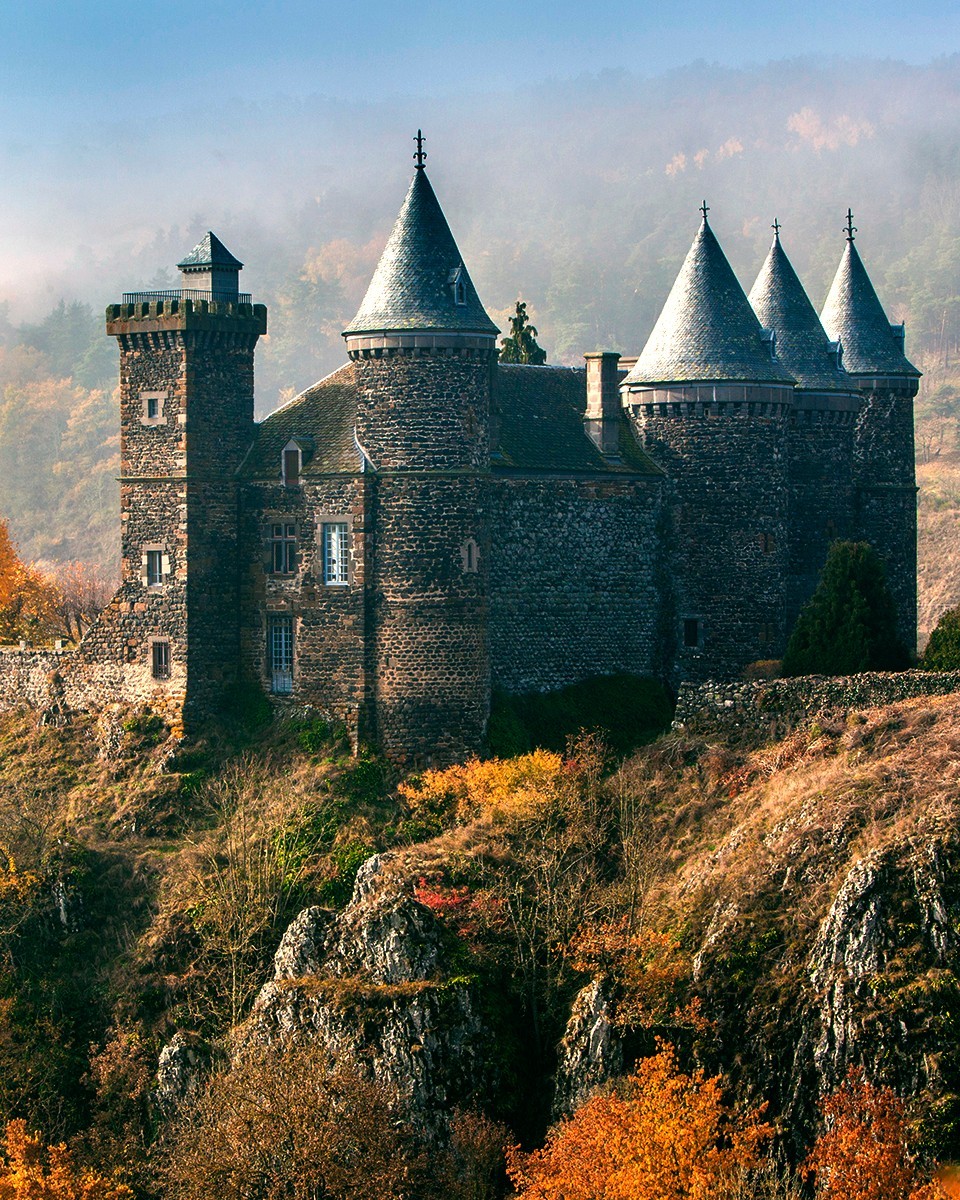Chateau du Sailhant
NYC-based architect Joseph Pell Lombardi purchased the medieval castle in France to implement a long-sought restoration project.
This website uses cookies to ensure you get the best experience.
Here are the Terms of Use and Privacy Policy
Here are the Terms of Use and Privacy Policy
OK

Joseph Pell Lombardi, NYC-based architect, the owner of Chateau du Sailhant
Artiom Ganin had a chance to talk with a prominent NYC-based architect Mr. Joseph Pell Lombardi who owns Chateau du Sailhant in Andelat, the Auvergne-Rhone-Alpes region, Central France. Mr. Lombardi possesses great expertise in restoration, preservation and adaptive reuse of historic buildings across the globe. In 1976, he bought and restored the Armour-Stiner House, an octagon-shaped and domed Victorian-style building in the state of New York. It is the only known fully domed octagonal residence modeled after an ancient classical temple. Mr. Lombardi also converted a 33-story NYC Financial District Gothic high-rise Liberty Tower to residential use. He bought the XII century Chateau du Sailhant in 1997. The restoration efforts which followed were full-scale and comprehensive: the unstable towers, the leaking roof, plaster work and utilities installed in the XIX century by the previous owners required urgent attention. In his work Mr. Lombardi was guided by the principle that "the facsimile is always worse than the ruin". The restored castle is a house museum and a holiday residence - he doesn't feel this medieval home is too big and uncomfortable. Mr. Lombardi says medieval fortresses were built to look bigger than they really are. Why? Because the prime purpose of such a fortress was to scare the hell out of any enemy.

A MEDIEVAL CHATEAU-FORT CREATED FOR DEFENSE
Castles and Palaces (CnP): I've read in your story about the chateau - "on a cold, gray, rainy day I drove through the mountains of the Auvergne and when I turned the last bend in the road, I knew in an instant that Chateau du Sailhant and I had found each other". Why out of many other castles, ruins and properties in France you chose Chateau du Sailhant?
Joseph Pell Lombardi (JPL): As a restoration architect, I looked for years for a project in Europe that would utilize my professional background and could be used as a retreat. My criteria was that it be of an architectural period unavailable in America, have an unstudied architectural history and be in need of conservation, in a remote location where foreigners are a rarity. I had studied Medieval European architecture during my education and had worked for clients on projects in Italy, France and Hungary, but, I itched to tackle a project in Europe for myself.
Joseph Pell Lombardi (JPL): As a restoration architect, I looked for years for a project in Europe that would utilize my professional background and could be used as a retreat. My criteria was that it be of an architectural period unavailable in America, have an unstudied architectural history and be in need of conservation, in a remote location where foreigners are a rarity. I had studied Medieval European architecture during my education and had worked for clients on projects in Italy, France and Hungary, but, I itched to tackle a project in Europe for myself.
CnP: The previous owner of the chateau, Jean-Paul Delbet, died in 1996. How did you learn about the castle being on sale?
JPL: I had an avocat in Paris who knew the executor for Jean-Paul Delbet's estate and my requirements.
JPL: I had an avocat in Paris who knew the executor for Jean-Paul Delbet's estate and my requirements.

CnP: When I hear 'French chateau' I immediately imagine a limestone French renaissance chateau of the Loire Valley, like Chateau de Chambord or Chateau de Blois! They are so light and joyous unlike buildings made of basalt rock, which look solid, serious, uncompromising and even brutal. I can assume that you prefer the latter. Why is that?
JPL: Unlike French renaissance chateaux, Sailhant is a medieval chateau-fort created for defense during troubled times with all of the attributes that you describe – "solid, serious, uncompromising and even brutal". These attributes were purposely done at the time to intimidate possible attackers - as one visitor commented Sailhant's appearance says "Go Away" instead of "Welcome"! I appreciated Sailhant being unapologetically a refuge to protect its occupants; its complexity, age, and remoteness appealed to me.
JPL: Unlike French renaissance chateaux, Sailhant is a medieval chateau-fort created for defense during troubled times with all of the attributes that you describe – "solid, serious, uncompromising and even brutal". These attributes were purposely done at the time to intimidate possible attackers - as one visitor commented Sailhant's appearance says "Go Away" instead of "Welcome"! I appreciated Sailhant being unapologetically a refuge to protect its occupants; its complexity, age, and remoteness appealed to me.

Chateau de Chambord, photo credits: Benh Lieu Song
CnP: What did you feel when the deal was sealed and you became the owner of the chateau?
JPL: Many months after I had first seen Sailhant on a cold rainy spring day, I took title on a brilliant autumn day in Paris. I felt I was embarking on a great, joyous project and it has lived up to all of that.
JPL: Many months after I had first seen Sailhant on a cold rainy spring day, I took title on a brilliant autumn day in Paris. I felt I was embarking on a great, joyous project and it has lived up to all of that.
Allen Sangines-Krause turned the ruins into a classic Irish castle fitted by modern standards
CnP: Do you remember you first night at your chateau? What was it like?
JPL: Although my first night was during the winter in a cold, smoke filled (from a backed up chimney) bedroom with a bathroom with icicles protruding from the faucets, I was so ecstatic about embarking on the Sailhant project, I was delightfully not uncomfortable.
JPL: Although my first night was during the winter in a cold, smoke filled (from a backed up chimney) bedroom with a bathroom with icicles protruding from the faucets, I was so ecstatic about embarking on the Sailhant project, I was delightfully not uncomfortable.

THE FACSIMILE IS WORSE THAN THE RUIN
CnP: Icicles in the bathroom! Looks like the building was not in the best shape despite previous restoration attempts of the XVIII and in the XIX centuries!
JPL: When I acquired Sailhant there were roof leaks resulting in deterioration of the plaster work and beams. The four large towers were unstable with severe structural defects. The XIX century work had resulted in the original semi-circular towers rising above the roof line as a full circle which rested precariously on compromised wood beams. The early XX century electrical system had been upgraded in only a few areas and the plumbing was antiquated.
JPL: When I acquired Sailhant there were roof leaks resulting in deterioration of the plaster work and beams. The four large towers were unstable with severe structural defects. The XIX century work had resulted in the original semi-circular towers rising above the roof line as a full circle which rested precariously on compromised wood beams. The early XX century electrical system had been upgraded in only a few areas and the plumbing was antiquated.
CnP: You have a solid background in architecture, preservation and restoration, you had worked on projects in France, Italy and Hungary. Every project is surely different and has its own challenges – what was the biggest challenge you faced with Chateau du Sailhant?
JPL: The biggest challenge at Sailhant was the stabilization of the towers, while keeping them in place. This was accomplished by very carefully replacing the failing wood beams immediately below the towers with steel beams sheathed in wood.
JPL: The biggest challenge at Sailhant was the stabilization of the towers, while keeping them in place. This was accomplished by very carefully replacing the failing wood beams immediately below the towers with steel beams sheathed in wood.
CnP: In 1998 you were granted the Erdody-Choron castle by the Hungarian authorities. Ten years later you returned the stabilized and conserved castle to Hungary. Basically you saved one of the few medieval castles in Eastern Europe. What was the deal with the French authorities? They should have been happy to have such a high-profile and experienced architect working to rescue Chateau du Sailhant. Did the French state offer you to share the restoration expenses or provide you with a subsidy?
JPL: Restoration expenses from the French state require opening to the public. Even though I eventually opened Sailhant to the public, I did not want to have public opening a perpetual requirement.
JPL: Restoration expenses from the French state require opening to the public. Even though I eventually opened Sailhant to the public, I did not want to have public opening a perpetual requirement.
CnP: The chateau has such a rich history – from the early medieval times when it was contested by the French and the English during the Hundred Years' War – to changing owners and continuous expansion and restoration efforts. You have several items in the castle collection like a Celtic Bronze Helmet, the "Bec de Passereau", a Burgundian kidney dagger – where did they all come from? Were they found during the restoration works you carried out?
JPL: The Sailhant collection was assembled from regional auction houses and dealers with some items sourced in Paris. I limited the search criteria to the Auvergne region of France.
JPL: The Sailhant collection was assembled from regional auction houses and dealers with some items sourced in Paris. I limited the search criteria to the Auvergne region of France.
CnP: The chateau was used for agricultural purposes. Obviously such approach to a historic building would affect any kind of interiors, decor, frescoes, etc. How bad was it? And which sources did you use to restore the interiors, to choose the right colors, etc.?
JPL: I assembled all available material including a 1925 book, Le Chateau du Sailhant et Ses Seigneurs, photographs taken prior to the nineteenth century work and books on French chateaux-forts and chateaux of the Auvergne. I commissioned France Brunon, a local genealogist and researcher, to search the archives throughout the country and commissioned Christian Corvisier, an architectural historian and Doctor of Medieval Archeology, to investigate the chateau, review Madame Brunon's findings and prepare a monograph. The conservation directive was to understand the construction chronology, conserve and leave intact the existing composition, install concealed heating, plumbing and electrical systems and to determine original finishes through paint and fabric analyses and investigative probes.
JPL: I assembled all available material including a 1925 book, Le Chateau du Sailhant et Ses Seigneurs, photographs taken prior to the nineteenth century work and books on French chateaux-forts and chateaux of the Auvergne. I commissioned France Brunon, a local genealogist and researcher, to search the archives throughout the country and commissioned Christian Corvisier, an architectural historian and Doctor of Medieval Archeology, to investigate the chateau, review Madame Brunon's findings and prepare a monograph. The conservation directive was to understand the construction chronology, conserve and leave intact the existing composition, install concealed heating, plumbing and electrical systems and to determine original finishes through paint and fabric analyses and investigative probes.
CnP: In 1881 the chateau was described as half-ruined. As far as I understand the old furniture had all been gone by that time – either sold at auctions or destroyed. Did you manage to trace down the authentic pieces and bring them back to the chateau after you bought it?
JPL: A few pieces from 1881 remained in the chateau, including a bed set (bed, night table, armoire and table). The Sailhant furnishings (XV to XIX centuries) were assembled from regional auction houses and dealers, including a few pieces original to the chateau. Again, the search criteria was the Auvergne Region with an emphasis on the Cantal Department.
JPL: A few pieces from 1881 remained in the chateau, including a bed set (bed, night table, armoire and table). The Sailhant furnishings (XV to XIX centuries) were assembled from regional auction houses and dealers, including a few pieces original to the chateau. Again, the search criteria was the Auvergne Region with an emphasis on the Cantal Department.
CnP: For you the castle is your holiday residence. Does anybody live there all the time to look after it?
JPL: There is a full time caretaker. When we are in place, we make use of the entire chateau with the Grand Salle being my favorite room. It is in a very original state, has period Gothic furnishings and provides a very powerful presence.
JPL: There is a full time caretaker. When we are in place, we make use of the entire chateau with the Grand Salle being my favorite room. It is in a very original state, has period Gothic furnishings and provides a very powerful presence.

CnP: The owner of XIII century Burg Seisenegg in Austria Mr. Maximilian Mautner Markhof told me that he believed any castle - no matter how big – was intended for one family only. I've always wondered is it really comfortable to live or stay in such a huge home where getting from point A to point B sometimes takes a lot of time?
JPL: Like many medieval chateaux, Sailhant is made to look larger, more imposing than it actually is. The original purpose was to intimidate, which is accomplished by having perimeter ramparts.
JPL: Like many medieval chateaux, Sailhant is made to look larger, more imposing than it actually is. The original purpose was to intimidate, which is accomplished by having perimeter ramparts.
CnP: One of your most challenging and notable projects is the 1978 conversion of Liberty Tower, Manhattan into 89 residential units on the upper floors. Why didn't you transform the chateau into an exclusive hotel?
JPL: Transforming Sailhant into an economically sound hotel would have required a severe compromise of the interiors.
JPL: Transforming Sailhant into an economically sound hotel would have required a severe compromise of the interiors.
CnP: Your castle is open for tourists, you host weddings and all kind of events – it brings some money. Is the money enough to run the chateau?
JPL: The income from the museum and the small rental houses at the base of Sailhant generally cover the expenses.
JPL: The income from the museum and the small rental houses at the base of Sailhant generally cover the expenses.
CnP: The owner of Burg Rheinstein tells his guests during a tour of his castle on the Rhine that 'I've been in the castle since 1763 and haven't seen anything supernatural!' I tend to believe ghosts do not exist but some castle owners are pretty sure they do. Have you experienced anything at your chateau you could not explain?
JPL: Like you and the owner of Burg Rheinstein, I have little belief in the supernatural. Nonetheless, I can confirm that Sailhant was inhabited by an unexplainable apparition – a stomping on the stairs at night, banging on my door and voices. I arranged for an exorcism through the Bishopric of Clermont-Ferrand.
JPL: Like you and the owner of Burg Rheinstein, I have little belief in the supernatural. Nonetheless, I can confirm that Sailhant was inhabited by an unexplainable apparition – a stomping on the stairs at night, banging on my door and voices. I arranged for an exorcism through the Bishopric of Clermont-Ferrand.

CnP: This is scary! Is there a legend about the chateau which you love and could share with me?
JPL: In the XVI century, during the French Wars of Religion, Louis Dubourg, the lord of Sailhant, headed the Protestants of the area and fought against the Catholic leader of the area, Jean de Lastic. Lastic seized Chateau du Sailhant and Louis Dubourg took the Chateau of Lastic. Curiously, in 1588, Louis Dubourg married Jeanne, the sister of Jean de Lastic.
JPL: In the XVI century, during the French Wars of Religion, Louis Dubourg, the lord of Sailhant, headed the Protestants of the area and fought against the Catholic leader of the area, Jean de Lastic. Lastic seized Chateau du Sailhant and Louis Dubourg took the Chateau of Lastic. Curiously, in 1588, Louis Dubourg married Jeanne, the sister of Jean de Lastic.
An eclectic castle in the heart of Russia on the Volga
CnP: God works in mysterious ways, doesn't he? Right after 9/11 you did not rule out selling the chateau. Was it just emotionally hard to focus on your project far away from home or was your US-based business affected as a result of the terrible terror attack?
JPL: For the first few weeks after 9/11, the economic world spun out of control and my working capital became depleted; the loss of Sailhant seemed to be a possibility. History seemed to be repeating itself – Sailhant had been seized in the XIV and XV centuries during the Hundred Years' War, confiscated in the XVI century during the War of Religions, auctioned in the mid-XVIII century, sequestrated in the late-XVIII by the Revolution, suffered owner bankruptcies in the late-XIX and early XX centuries and a sale upon Jean-Paul Delbet's death at the end of the XX century. Fortunately by mid-2002, New York City and my financial affairs stabilized and the work continued on Sailhant.
JPL: For the first few weeks after 9/11, the economic world spun out of control and my working capital became depleted; the loss of Sailhant seemed to be a possibility. History seemed to be repeating itself – Sailhant had been seized in the XIV and XV centuries during the Hundred Years' War, confiscated in the XVI century during the War of Religions, auctioned in the mid-XVIII century, sequestrated in the late-XVIII by the Revolution, suffered owner bankruptcies in the late-XIX and early XX centuries and a sale upon Jean-Paul Delbet's death at the end of the XX century. Fortunately by mid-2002, New York City and my financial affairs stabilized and the work continued on Sailhant.
CnP: There can be various approaches towards a ruined property. Some tend to rebuild according to old plans and drawings. Others preserve what's left to incorporate it into their contemporary buildings. There are also people who believe ruins should remain ruins and the only thing we can do about them is to conserve the place and make it an esthetically appealing space for everyone to enjoy. Which approach works for you?
JPL: I adhere to the preservation principle that "the facsimile is always worse than the ruin". In a conservation project of the complexity of Sailhant, I returned again and again to this maxim. The decoration and location of the kitchen, informal dining room, library, main dining room, salon, chapel and bathrooms were retained as they were in the XVIII and XX centuries. The decoration of the Grande Salle, the Seigneur's Chamber, the Donjon, the Entry and the latrines were retained as they were in the XIV and XV centuries with decoration, which had evolved over the centuries, left intact.
JPL: I adhere to the preservation principle that "the facsimile is always worse than the ruin". In a conservation project of the complexity of Sailhant, I returned again and again to this maxim. The decoration and location of the kitchen, informal dining room, library, main dining room, salon, chapel and bathrooms were retained as they were in the XVIII and XX centuries. The decoration of the Grande Salle, the Seigneur's Chamber, the Donjon, the Entry and the latrines were retained as they were in the XIV and XV centuries with decoration, which had evolved over the centuries, left intact.
CnP: Lots of individuals would love to buy and revive a dilapidated castle for various reasons – what piece of advice would you give to such people?
JPL: Don't look before you leap!
JPL: Don't look before you leap!
An aerial view of Chateau du Sailhant's towers
A view of Chateau du Sailhant's keep
Chateau du Sailhant's Neo-Gothic library
Chateau du Sailhant's dining room
Chateau du Sailhant's gardens
A vintage car near Chateau du Sailhant's towers
Chateau du Sailhant's gardens
Spring has come to Chateau du Sailhant
We very much hope that you liked the interview with Joseph Pell Lombardi, the owner of Chateau du Sailhant in Central France.
Don't miss new stories by castle owners!
Photo credits: Chateau du Sailhant
You can always get in touch with us via castlesandfamilies@gmail.com
Photo credits: Chateau du Sailhant
You can always get in touch with us via castlesandfamilies@gmail.com